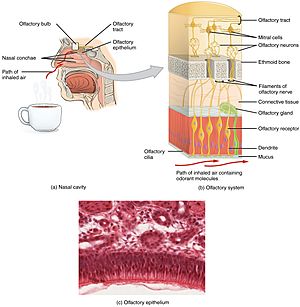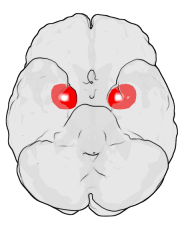Olfactory system facts for kids
The olfactory system is how we, and many animals, experience the sense of smell. It's a special sensory system that helps us detect different smells around us.
Most mammals and reptiles have two main parts to their olfactory system.
- One part is the main olfactory system. It helps them smell things that are floating in the air, like the scent of food or flowers.
- The other part is called the accessory olfactory system. This system is good at sensing smells that are in liquids. Often, it detects special chemical signals called pheromones. These pheromones can influence how animals behave, like finding a mate.
The olfactory system is often compared to the gustatory system, which is our sense of taste. Both systems are "chemosensory." This means they turn chemical signals into nerve impulses. These impulses then travel to the brain, where they become the smells or tastes we recognize.
Contents
How the Brain Smells
The part of the brain that handles smell is called the rhinencephalon. In humans, it's a small area. But for other vertebrates, it's much more important.
Brain Areas for Smell
- The piriform cortex is likely the main area for figuring out what a smell is.
- The medial amygdala helps with social actions, like recognizing other animals of the same species or finding a mate.
- The entorhinal cortex helps connect smells with memories. For example, a certain smell might remind you of your childhood home.
Scientists are still learning exactly how these parts of the brain work together.
Nobel Prize in Smell
In 2004, Linda B. Buck and Richard Axel won the Nobel Prize in Physiology or Medicine. They won for their amazing work on the olfactory system. By studying rat DNA, they found that mammals have about one thousand different genes for olfactory receptors. These receptors are like tiny sensors that detect different smells.
When the Olfactory System is Damaged
Sometimes, the sense of smell can be harmed. This can happen because of a brain injury, cancer, or breathing in toxic gases. To check for damage, doctors might give a patient something to smell. Then, the patient tries to guess what the smell is.
Related pages
Images for kids
-
Vesalius' Fabrica, 1543. This old drawing shows the human Olfactory bulbs and olfactory tracts outlined in red.
See also
 In Spanish: Sistema olfativo para niños
In Spanish: Sistema olfativo para niños






